Aim High: What to Know About Adding a Library Ladder
http://decor-ideas.org 09/27/2014 19:13 Decor Ideas
Studies, kitchens, living rooms and bedrooms can benefit from lofty storage. The problem is that no matter how frequently you use those items, you’ll still need a way to get to them. And the library ladder is just the thing to get you there. But there’s a lot to consider when adding one of these elegant pieces to your home. Here’s what you’ll want to know about cost, structural support and style.
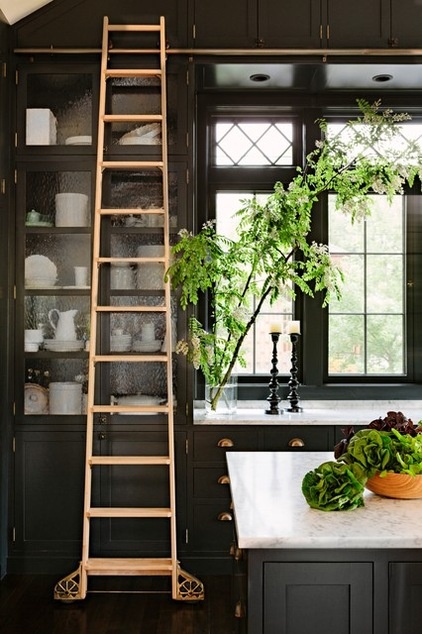
Important Considerations
Before proceeding with a library ladder project, make sure your space meets these four requirements.
1. Determine if there’s adequate support at the location you want to install the rail. If not, you’ll need to add it. Keep in mind that the rail needs to support not only itself and the ladder, but the person standing on it and the torque created by that person’s movement. Klint Peacock of Bartels Doors, who represents MWE brand ladders, says that if you’re mounting onto wood cabinetry, as shown here, you don’t need additional support because the unit itself is already solid wood.
However, if the rail is to be mounted directly to a wall surface, extra support will likely need to be built into the wall if it’s not concrete. Peacock explains that when someone is sliding the ladder or even climbing on it, there is no force pulling down on the rail or the mounts (the floor receives the force). The problem arises with the force created when the ladder is pulled outward. While the ladder mounts are extremely load bearing, they need to be mounted to something solid.
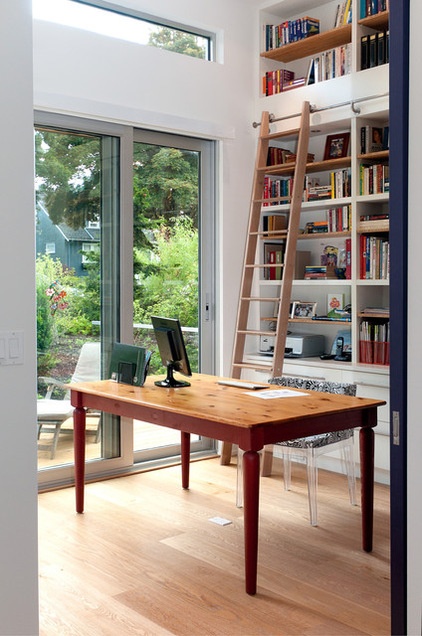
2. The floor surface must be completely level. If you have an older house with floors that have a charming slope to them, a library ladder won’t work for you. Hard-surface floors, such as hardwood and tile, are ideal. Just make sure the tile or stone is level and doesn’t have a pronounced dimension variance, like in the clefts of slate. Otherwise, the ladder may get caught on high points. Carpet isn’t recommended either unless it is a level loop with a very low pile.
3. You must have a minimum clearance space from the center of the track to the ceiling, which is needed for installation. Some manufacturers require a 7-inch clearance, but this dimension could vary with others, so it’s prudent to verify first.
4. Make sure you meet the weight requirements of the ladder you’re interested in. For example, MWE’s ladders have a 265-pound load capacity.
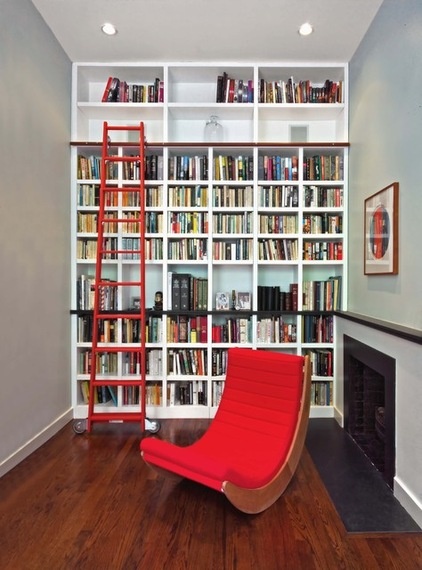
Choosing a Style
Library ladders come in three general configurations, determined by the use and surrounding architectural elements.
Straight. The straight style is pretty self-explanatory. It’s a straight up-and-down ladder that is meant to go against a vertical wall or cabinetry, as seen in this study.
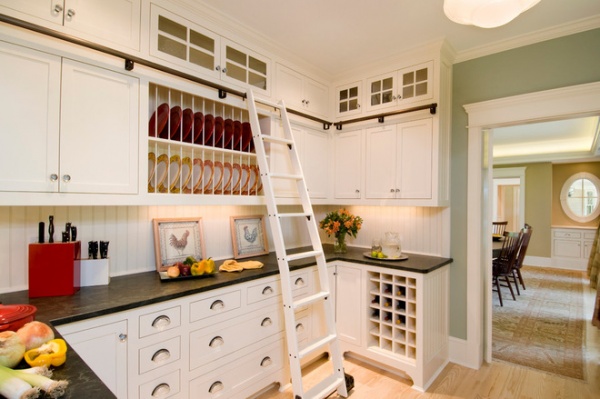
Bent. A bent library ladder, seen here, sports a bend midway to work around an obstruction such as a countertop or radiator cover. A ladder manufacturer can make this ladder based on the obstruction’s height and depth dimensions that you provide.
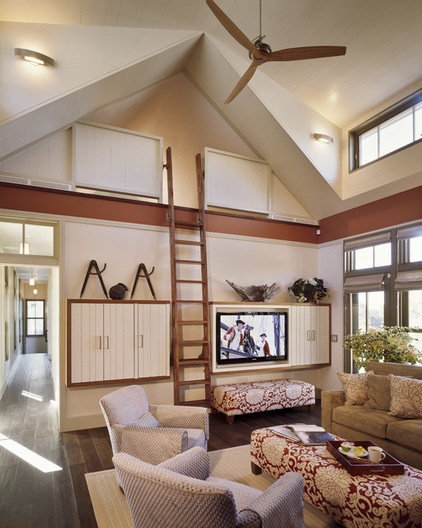
Loft. A loft-style ladder has distinct extended side rails at the top to accommodate accessing a loft or mezzanine level.
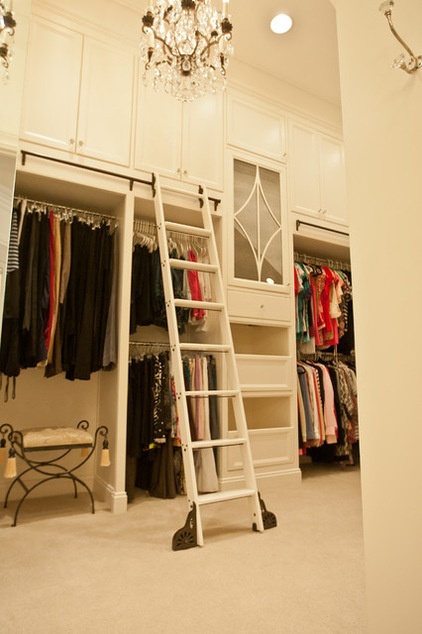
Materials
Wood. Wood library ladders usually have a more traditional look. While more substantial in scale, they also have flat steps, and some have a beautiful cast-lace-like star pattern housing over the bottom wheels that give them a Victorian-era flair. (More pared-down options are available too). Wood ladders are made of solid hardwoods, including birch, cherry, mahogany, red and white oak, and walnut. They can be left unfinished, stained or just coated with a clear finish.
However, if wood grain isn’t your thing, wood ladders can also be painted, as shown here. Painted finishes can teeter between traditional and contemporary, depending on the color and context. The hardware finish options for wood ladders and the rails are attractive and extensive.
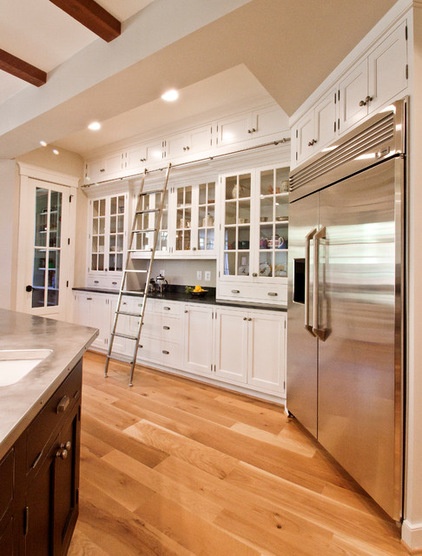
Metal. In contrast to wood ladders, a metal library ladder is visually lighter and lends itself to more streamlined spaces. However, the example shown here harmonizes beautifully with the more traditional components of the kitchen.
Michael Macklin of Cameo Kitchens says his client spent much time selecting the ladder and finally decided on the Akzent line by MWE. Macklin says it has the clean lines and simple tread style his client was looking for that weren’t found in a wood ladder. Many metal ladders are left in their metallic finishes, but some manufacturers, such as Alaco, also offer powder coating.
Macklin says this project totaled $3,820, including the railing and mounting hardware.
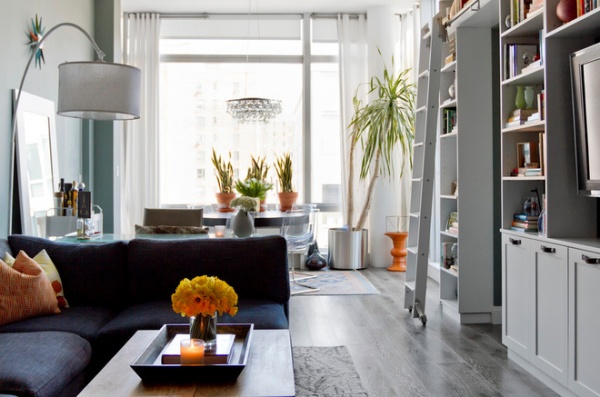
Mounting Style
Library ladders either have a J-style hook at the top that allows the user to manually remove or slide the ladder along the track, or there’s a rolling mechanism that is permanently attached to the top railing.
Hook. A hook-style ladder is required only if you need to pick up the ladder and move it to another piece of unconnected track. (Note that tracks can turn inside corners, so if you want to access two intersecting walls, you can still pursue a ladder with rolling hardware.) However, some prefer the look of the hook style, like designer Amanda Gorski of Homepolish. She says her project shown here uses a hook-style ladder made by Rockler. The ladder was included in her design of the new bookcase. “I haven’t met a client yet that doesn’t love the idea of a library ladder,” she says. “They are not only practical, but a fun twist to a fixed wall unit.”
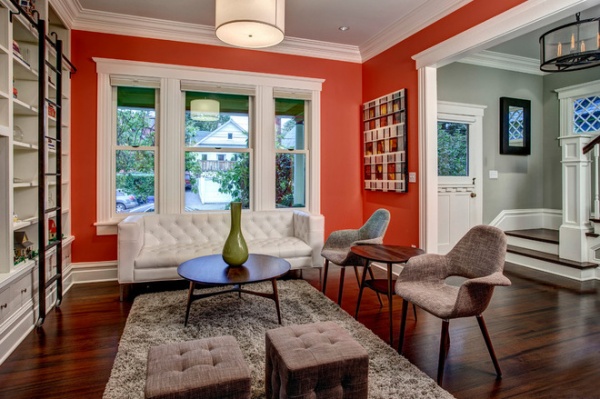
If you’re considering the hook route, be sure to investigate the weight of the ladder you’re interested in and also take into consideration the height and if there are any obstructions, such as pendant light fixtures, that may interfere with moving the ladder to another piece of railing.
The hook-style ladder shown here was custom made for Board and Vellum by Boiler Room Custom Metal in Seattle. Board and Vellum designer Jeffrey Pelletier notes that because the bottom portion of the ladder is wheeled, one adult can lift it quite easily. In fact, Pelletier says, this ladder is actually transferred between the living room and adjacent kitchen, where there is another section of railing. “It’s a fun feature in the house that people love to interact with,” he says.
Pelletier says this completely bespoke ladder was $4,000, including two sections of railing.
The weight of MWE’s hook ladders ranges from 30 to 70 pounds, depending on the tread selected, Peacock says. And while that’s fine for an average person to pick up, children and seniors may have a more difficult time. Unlike the Alaco and Putnam Rolling Ladder examples, MWE’s ladder designs do not have wheels on the bottom.
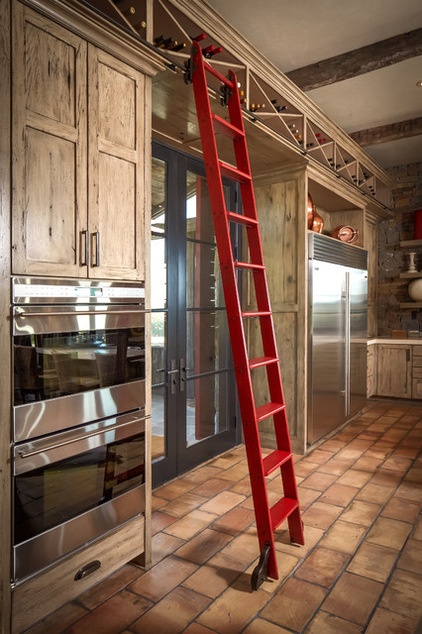
Rolling. This striking red wood ladder is an example of a rolling library ladder. Again, a rolling-style ladder is permanently attached to the track and needs to maintain its connection with it. It’s not removable like the hook-style ladder. Two wheels — one above and another below the top rail — guide the ladder left to right along its track. Meanwhile, two bottom wheels finished off with fetching cast wheel covers assist in the movement of the ladder.
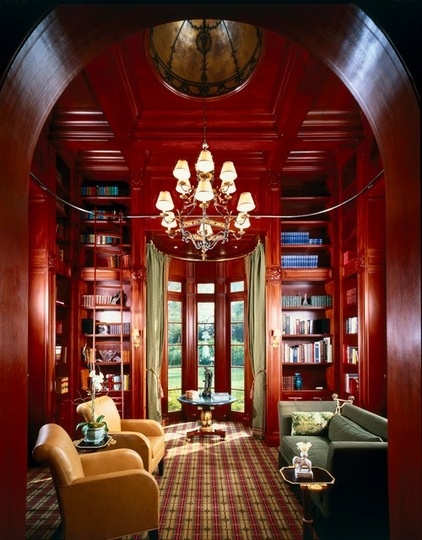
This elegant library shows a rolling library ladder on a curved track to accommodate 90-degree corners. Tracks can be curved to adapt only to inside corners; outside corners are impossible. Also, only rolling ladders work on curved tracks, so this is not an option for hook-style ladders. The user will have to lift the ladder up a bit more (versus a straight run) to maneuver the ladder around the curved portion of the track, but it’s quite easy to do.
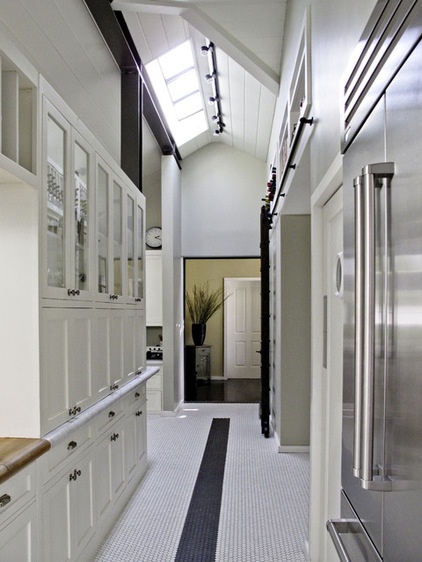
In or Out?
A lot of people immediately dismiss owning a library ladder because they’ve seen them sticking into the space, becoming a tripping hazard when not in use. However, many are unaware that most ladder manufacturers offer mechanisms to push the ladder snugly against the wall or cabinetry, like in this kitchen, designed by Tim Barber. Barber wall mounted this Alaco ladder system to drywall with 2-inch by 4-inch blocking behind it, and it couldn’t work better in this narrow passageway. Alaco manufactures an upper slide-bar assembly for its ladders to achieve this vertical solution.
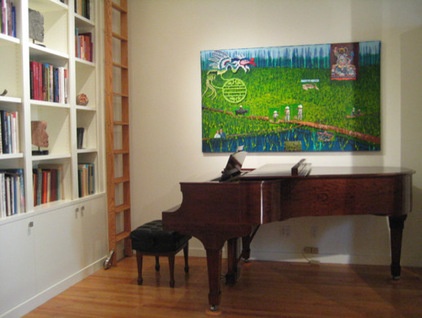
Putnam Rolling Ladder offers a top-slide feature for both its rolling and hook-style ladders that allows it to be pushed vertically to conserve space when not in use, as seen here.
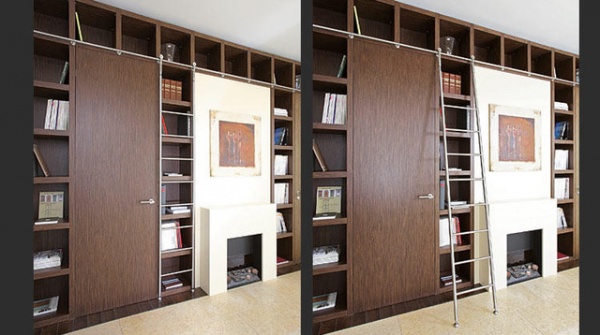
Klassik SL.6060Likewise, MWE’s Klassik series ladder, seen here, has a telescoping option, which Peacock explains is “a pivoting wheel that allows the ladder to sit flush with the wall when not in use, and the ability to pull the ladder out when in use.”
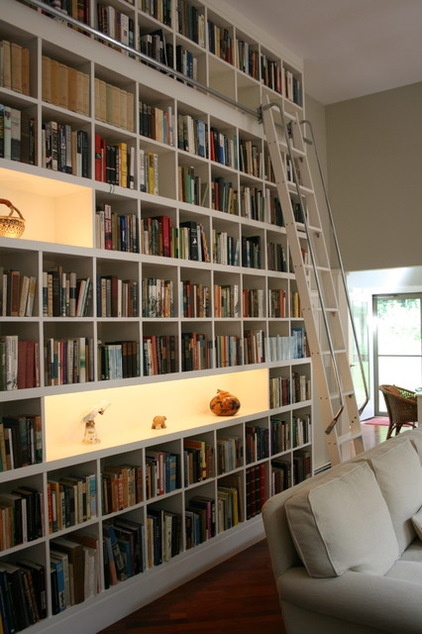
Safety Options
Using the ladder properly offers the highest level of safety and appeals to most folks’ common sense. Always maintain three points of contact at all times (both hands and a foot). Don’t try to slide the ladder while standing on it, and instead of overreaching, move the ladder to a new position.
While library ladders are quite sturdy and safe by design, most companies offer additional safety options. Handrails are one, as seen on this ladder. Rubber nonslip safety treads are another option.
Safety wheels and auto-stop functions, which lock the moment the ladder has weight placed on it, are also available.
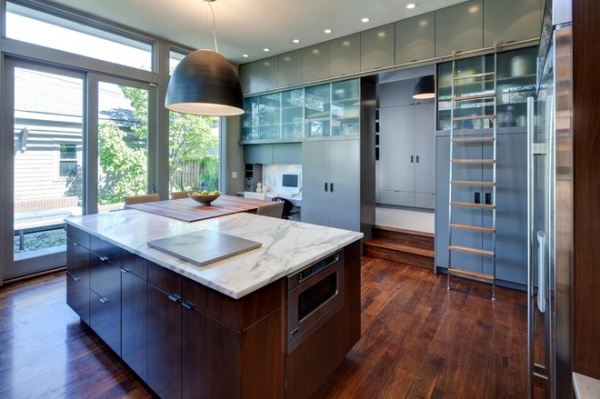
Cost
Because a library ladder project requires precise measuring, estimating, skilled installation and possibly construction drawings, it is highly encouraged (if not required) to hire an architect, a contractor or an interior designer for this project. A library ladder should run in the ballpark of $2,500 to $4,000 installed. However, the price varies based on the length of the railing, type of ladder, wood species, labor rates, freight and location.
Omar Tolentino of Alaco says the list price of the company’s standard 9-foot maple wood ladder is $1,825 and includes the plated hardware. A satin nickel railing runs $26 per linear foot.
See more great home projects
Related Articles Recommended












